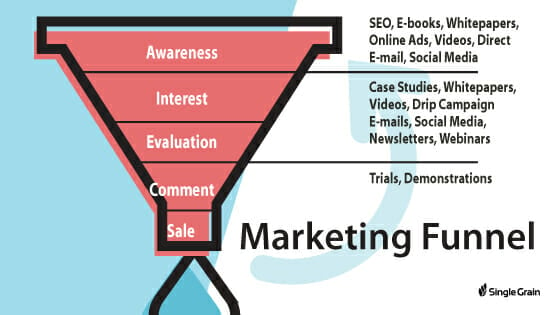If you sell a physical product, listing it on Amazon should be a part of your overall marketing strategy no matter where your primary store is. Another part of that strategy should be paying for advertising on the platform.
Facebook and Google have been dominating the digital advertising space for years now, but Amazon is at number three and growing fast: they made almost $10 billion in ad revenues in 2019, which is almost 8% of the digital ad market, and up more than 30% from the year before. Here’s what’s projected for 2020 and beyond:

Amazon recently released a bunch of new products and tools for advertisers, along with more places to advertise. If you’re a seller and want to compete for customers in 2020 and make sure your products are seen, you need to take advantage of these new opportunities.
Book My Free Marketing Consultation
What Makes Amazon Ads Different
Google has the name recognition and the inventory, but Amazon has something more powerful: intent. If I search for “best running shoes” on Google, I may just be in the research phase. But if I search for the same phrase on Amazon, I’m more likely in purchase mode.
That’s one of the reasons why sellers who have their own e-commerce sites should also be selling and advertising their products on Amazon. This enormous, worldwide platform exposes your product to people who are ready to buy something. And that’s powerful.
Another advantage is that, because conversions happen right on the platform, it’s much easier to measure performance. You can clearly see every stage of the sales funnel:
Don’t think of Amazon as a retail site — think of it as a search engine. As the sheer volume of products on Amazon continues to increase, so does the number of product searches.
Dive Deeper:
4 Amazon Ads Trends You Can’t Ignore in 2020
Here are the four biggest Amazon trends to keep an eye on in the new year, and to try out if it makes sense for your business.
Trend #1: Amazon Will Be More Pay-to-Play
Much like Google, Amazon used to be a platform where the right keywords would guarantee you a high search ranking. Not anymore. Amazon recently increased its inventory for sponsored products.
This is what you get at the top of search results when you search for “gourmet gift baskets”:

The featured section at the top of the screen is all sponsored, as are the first three results — which means that there’s only one product above the fold that isn’t a paid placement.
And if you scroll all the way down to the bottom, there’s another completely sponsored row of products there, too:
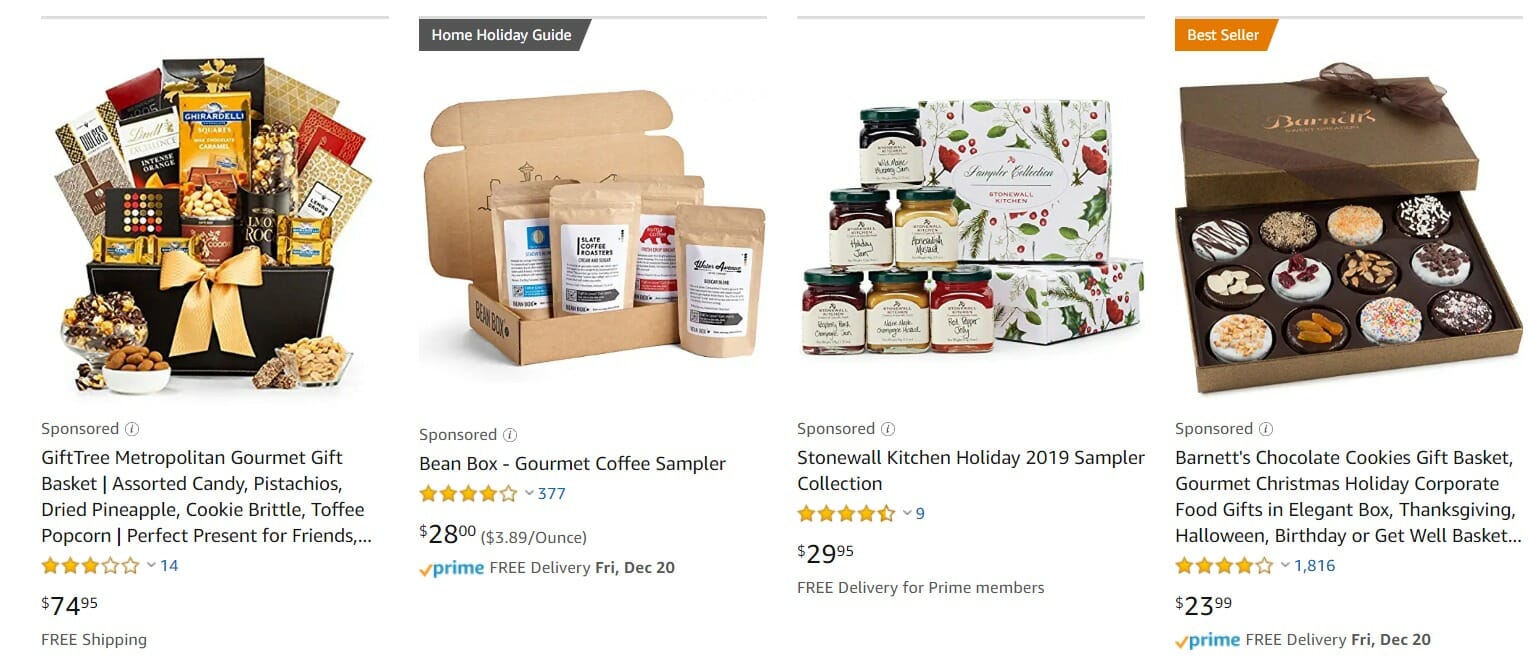
In 2018, marketplace ad firm Quartile analyzed more than one million Amazon orders and found that orders generated by ads accounted for 25% of total sales. Compare that to 2017, when it was just 16%, and you can see which way Amazon’s sales are trending.
Whether this is good for the customer or not is debatable, but it’s certainly good for Amazon. People call Amazon a retail and e-commerce company, but they don’t actually make the majority of their money from online sales. With rock-bottom prices and free shipping, shopping isn’t where the company makes its money — AWS (Amazon Web Services), advertising and third-party seller services is.
It makes sense that Amazon would try to offset their losses from being the cheapest, fastest place to shop with advertising dollars.
If Amazon sellers aren’t running sponsored ads, there’s a good chance that their products aren’t going to be seen. Click To Tweet
Dive Deeper:
Trend #2: Amazon Ads Will Get More Expensive
As more sellers flock to Amazon’s advertising platform, expect to see fiercer competition for placements. That means a higher cost-per-click (CPC).
The average CPC on Amazon is $0.97:
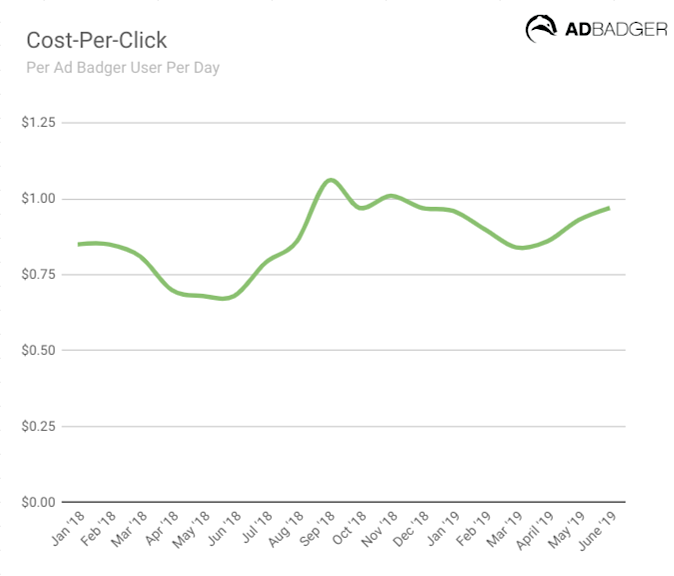
But yours may be higher or lower depending on how competitive your industry and products are. If you’re selling skincare products, for example, that number will be much higher than if you sell pool accessories.
Amazon will likely devise creative ways to accommodate the growing demand for advertisers with more inventory, but they can only go so far. Customers are already frustrated by the number of sponsored ads in search results, so they can’t increase those and still call themselves a customer-centric company.
Regardless of increasing costs, you can focus on the ad format that best aligns with your advertising goal:
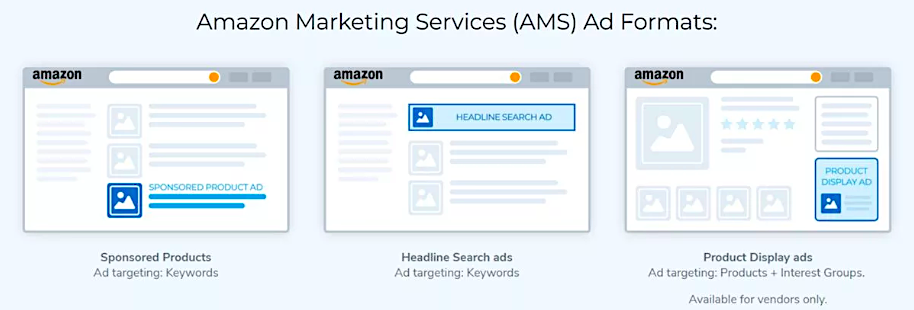
Book My Free Marketing Consultation
Trend #3: Amazon Sponsored Display Allows Off-Platform Advertising
In the fall of 2019, Amazon launched Sponsored Display, giving advertisers the ability to promote products both on and off of the platform. The company is taking a page out of Google’s playbook with the self-service platform:
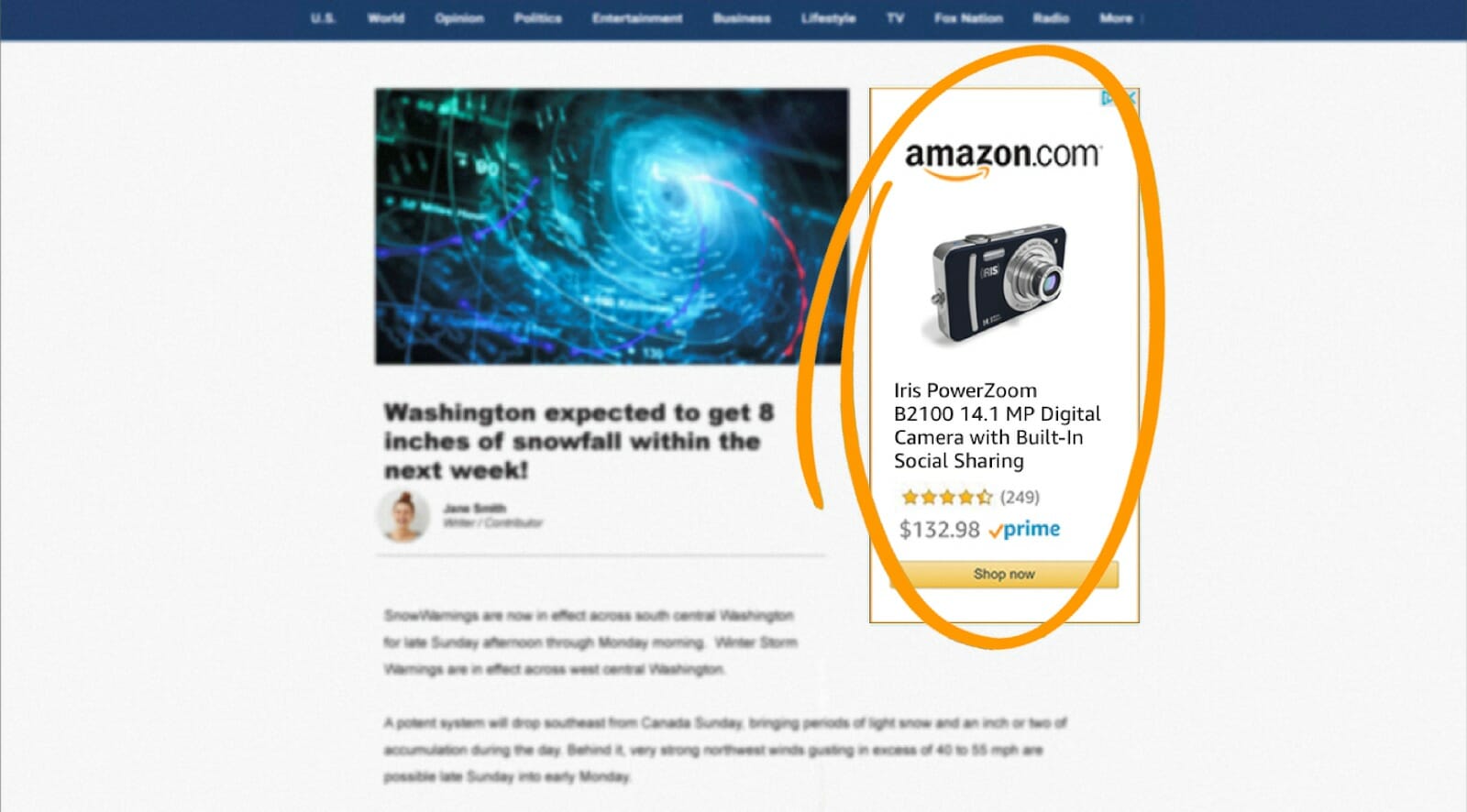
As we all know, display advertising click-through rates are generally less than 1%. If you’re simply throwing products onto websites and apps, you probably won’t see much ROI.
Where Sponsored Display ads have huge potential is with retargeting. Now if you look at a product on Amazon, it can follow you as you browse websites and use apps. And that’s huge for sellers.
You can set up a Sponsored Display campaign in just a few minutes, making it an easy option for sellers without much advertising experience or a ton of inventory they want to advertise. However, a major downside is the lack of customization for audience targeting, but the company will likely make improvements to that down the road.
Sponsored Display is currently available for professional sellers enrolled in the Amazon Brand Registry, vendors and agencies with clients who sell products in eligible categories on Amazon:

Dive Deeper:
Trend #4: Amazon Video in Search Ads
It’s no secret that video marketing is effective: 68% of consumers would rather learn about a new product via video than through any other platform, so it was only a matter of time before Amazon rolled out video ads.
Amazon launched video as an ad option in 2019, and you can expect to see a lot more video in search results in 2020:

Video ads are displayed below the fold for relevant keywords. As of right now, they’re only available in the mobile shopping app on iOS and Android, but we think that will probably expand to include desktop and mobile sites eventually. Video ads can point to a product detail page, custom landing page or Amazon Store, and require a minimum budget of $35,000.
Here’s an example video ad from littleBits: “By featuring a child unboxing and demoing the product, littleBits’ video in search ad helps customers visualize themselves (or their kids) using it”: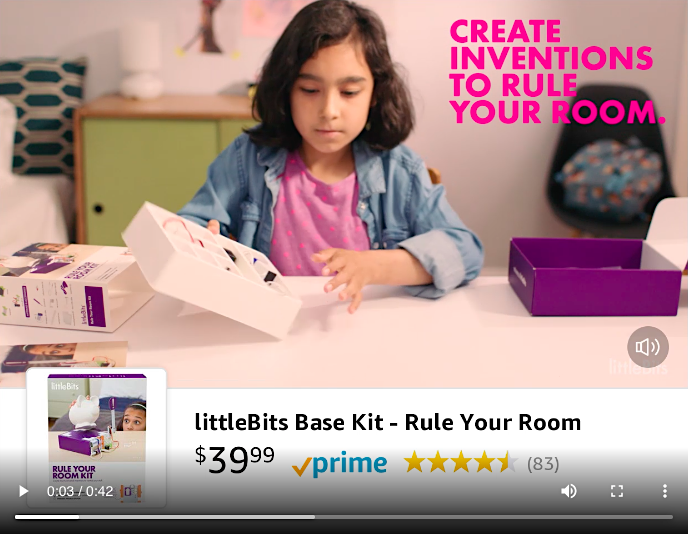
Amazon Ads Case Study: Rocco & Roxie Supply Co.
The small, family-owned business Rocco & Roxie Supply Co. launched in 2013, selling pet products like shampoos, bandanas and jerky. They invested heavily in Amazon advertising, setting up a custom landing page and experimenting with advertising solutions, including Sponsored Products, Display Ads, video in search ads, and Amazon DSP:
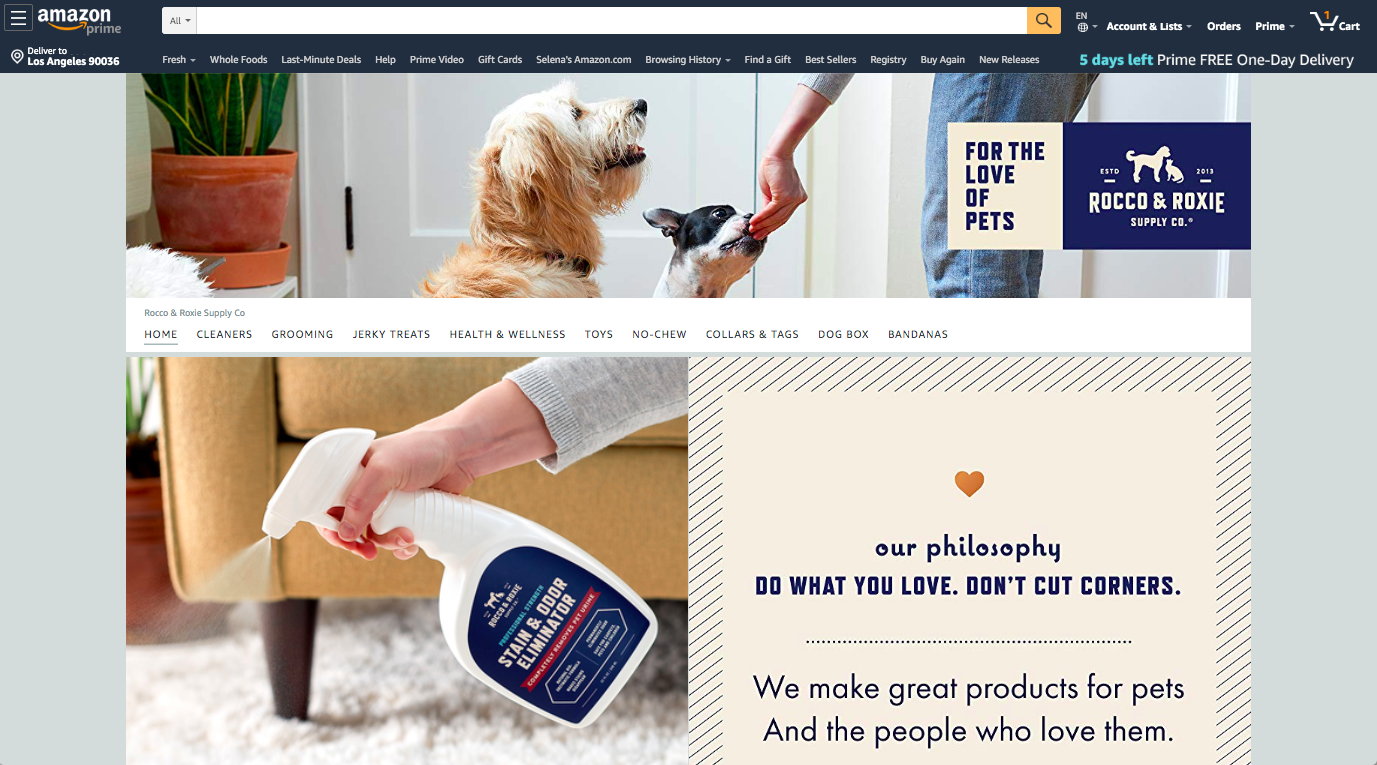
Amazon’s advertising solutions allowed them to compete with established pet brands on a level playing field, and they’ve seen month-over-month growth in brand searches as more and more people become aware of them. Plus, they’ve managed to build a large, loyal customer base.
When video ads were released, Rocco & Roxie Supply Co. were one of the first advertisers to try them. According to Matson Magleby, the company’s co-founder, video ads in search had the highest ROI of any of their campaigns due to increased engagement:
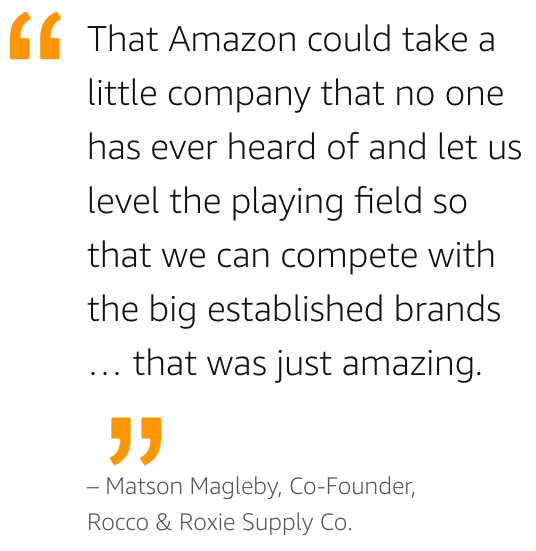
For small brands who want to grow and aren’t afraid to spend a little money to get there, advertising on Amazon can be a really effective way to compete with bigger businesses in your industry.
Dive Deeper:
Take a look at our 3-minute video on Amazon Advertising 101:
Paying Attention to the Basics Is Still Important on Amazon
Amazon is pay-to-play, but that doesn’t mean you should just focus on advertising. Your product rank is still important, so keep these search ranking factors in mind for 2020:
- Sales: If you get more sales than anyone else for a keyword, you get the coveted “Best Seller” tag. That translates to even more sales.
- Reviews: Make sure your happy customers are leaving you glowing reviews.
- Questions: If consumers post them, answer them promptly and accurately.
- Image size/quality: Make sure your products look good.
- Price: Keep your prices in line with other results on your search pages.
- Complete product page: Don’t leave fields blank when you’re filling out your product listing. Information should be complete and up-to-date.
- Order speed: If your product isn’t available for Prime shipping, make sure it’s still processed and shipped quickly.
- Keywords: Ensure that they are relevant to each of your products.
If you can get onto the first page of Amazon’s search results, you have a better chance of making a sale — even if you aren’t at the top.
Get an edge over digital marketing with our epic trends guide: 42 Digital Marketing Trends You Can’t Ignore in 2020
Final Thoughts
As Amazon continues to grow its offerings for advertisers, the opportunity for organic ranking in search will keep shrinking. But if you sell products, having a presence on Amazon is a necessary evil.
Amazon’s regular sponsored ads continue to be an effective way to raise your profile and get more sales. But you should definitely give newer products like Sponsored Display and Video Ads a chance to see if they work for you.
Expect Amazon to keep rolling out tools, ad types, and inventory in 2020. And who knows? Maybe by 2025, they’ll catch up to Facebook and Google!

